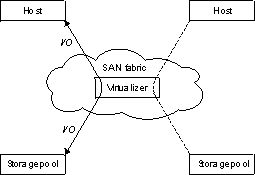When used as an external storage system, Lenovo Storage V7000 provides symmetric virtualization.
Virtualization splits the storage that is presented by the storage systems into smaller chunks that are known as extents. These extents are then concatenated, using various policies, to make volumes. With symmetric virtualization, host systems can be isolated from the physical storage. Advanced functions, such as data migration, can run without the need to reconfigure the host. With symmetric virtualization, the virtualization engine is the central configuration point for the SAN.

The virtualization engine directly controls access to the storage and to the data that is written to the storage. As a result, locking functions that provide data integrity and advanced functions, such as cache and Copy Services, can be run in the virtualization engine itself. Therefore, the virtualization engine is a central point of control for device and advanced function management. Symmetric virtualization can be used to build a firewall in the storage network. Only the virtualization engine can grant access through the firewall.
Symmetric virtualization can cause some problems. The main problem that is associated with symmetric virtualization is scalability. Scalability can cause poor performance because all input/output (I/O) must flow through the virtualization engine. To solve this problem, you can use an n-way cluster of virtualization engines that has failover capacity. You can scale the additional processor power, cache memory, and adapter bandwidth to achieve the required level of performance.Additional memory and processing power are needed to run advanced services such as Copy Services and caching.
The Lenovo Storage V7000 uses symmetric virtualization. Single virtualization engines, which are known as node canisters, can be combined in pairs (control enclosures) to create a clustered system.